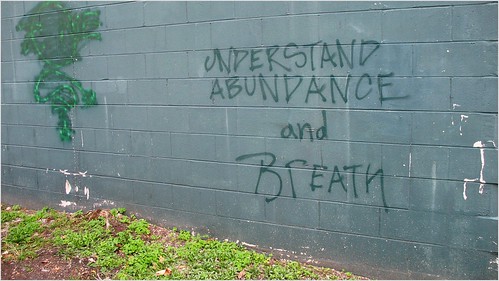
The November Nonprofit Blog Carnival is about the theme of how nonprofits can move from a scarcity mindset to an abundance mindset. I’ve been thinking a lot about scarcity and abundance mindsets lately because the first chapter of the Happy, Healthy Nonprofit: Impact without Burnout book I’m writing with Aliza Sherman asks this question: “Why do people who work for nonprofits not practice self-care and burnout?” The scarcity mindset exists when it comes to self-care because there is a lack of belief that self-care can help their organization achieve better results. Not prioritizing self-care, as an individual or as part of the organization’s way of working can lead to burnout.
A scarcity mindset is defined as the belief that everything is limited. The scarcity assumption is based on: there’s not enough of what our nonprofit needs to go around and there’s more out there that our organization needs but we don’t have it. Many nonprofit senior leaders believe that self-care is not work and that when employees practice it – like leaving the office after only 8 hours, the organization pays the price of not achieving results. This makes it difficult for staff to strike a meaningful, sustainable balance between work and self-care because it does not permeate a organization’s culture or fundamentally change staff behavior.
In his book, The 7 Habits of Highly Effective People, Stephen Covey refers to the “scarcity mentality” as a zero-sum paradigm of life. Covey notes that these views of life have been deeply scripted within us, suggesting this mindset goes beyond the nonprofit workplace. The principle of “not-enough-ness” extends far beyond money, resources, and staffing. It also contributes to “FOMO” (fear of missing out). In terms of self-care, here is how it plays out: “There’s not enough time to get everything done with limited staff, so staff have to work long hours and sacrifice self-care.”
In their book, Scarcity: Why Having Too Little Means So Much, Harvard economics professor Sendhil Mullainathan and Princeton professor of psychology Eldar Shafir introduce the new psychology of scarcity which shows that people living in scarcity actually experience changes in how their brains work that makes it difficult to solve the pressing problems. “Scarcity captures the mind. The mind orients automatically, powerfully, toward unfulfilled needs. Scarcity is more than just the displeasure of having very little. It changes how we think.”
For nonprofits, to get to impact without burnout, we need to change from a scarcity mindset to an abundance mindset, especially around self-care. Nonprofits know the importance of self-care, yet the scarcity mindset keeps them from actually doing it. Perhaps because some people feel guilty about practicing self-care or there are unspoken rules that if you take time for yourself you are not serious about work. It means changing the way we think about self-care in the first place. It isn’t something that we do as a luxury – it is part of being able to sustain and do the hard work we do in our nonprofits.
I’m thinking about practicing self-care in two ways. Practicing self-care is an abundance mindset. First, there is the individual and what that person can do for themselves, even if the organizational culture or internal policies do not reinforce the importance of self-care. Here’s some great self-care tips from Nonprofits With Balls and Tara Collins on the Nonprofit Marketing Guide. And, that’s an great way for change, from the bottom up. But how do we get organizational mindsets to shift or at least create an environment where self-care is valued and becomes the norm?
Recently, I had the opportunity to facilitate two design labs with nonprofit professionals. The most recent one was during the The National Arts Marketing Project Conference. After sitting the problem, we re-framed the question as : “How can we shift mindsets (org/ind) around self care so that stakeholders (staff/leadership/board) believe it serves the organization’s mission?” Changing mindsets is not something that happens overnight, but I thought these creative ideas offered some great fodder for discussion which might lead to change.
Self-Care for Success
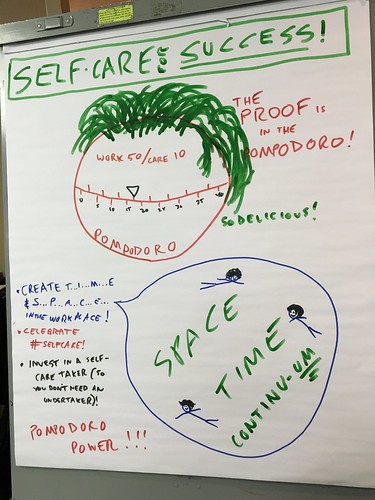
This idea was all about having a consultant or staff person whose job was to help staff members develop self-care strategies and actually took the time for self-care. The tagline “Invest in a Self-Care Taker Before You Need An Undertaker.” Some larger nonprofits do have wellness programs that provide education about self-care activities and incentives – for example if they attend a training, they get a discount on their health care policy. I’ve also heard stories from smaller nonprofits where a donor has donated gift certificates for massages for staff, especially during stressful work times. This concept also included having a communications campaign which included a #selfcare hashtag that people used to celebrate selfcare.
Gamify Self-Care

This concept was how to gamify self-care in nonprofits through a systems of rewards and reminders. The app (or it could even be a simple deck of cards or assessment survey) would help staff identify and customized a strategy for self-care and then be encourage to take time for those activities. This concept was acted out by artists that brought the game to life in a very funny way and it prompted some fun (non-scarcity mindset) thinking. One person suggested “The Wheel of Wellness” in the office that you could spin and it would give you self-care suggestions.
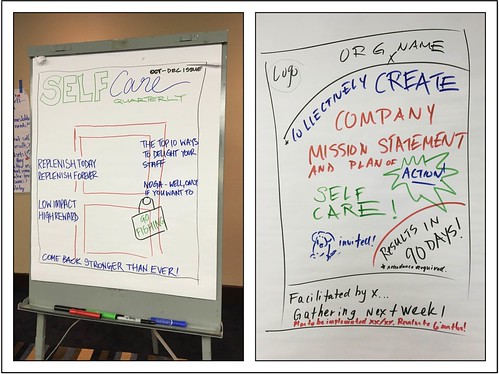
These two concepts were similar because they focused on educating staff at an organization to practice self-care without guilt – and to not only provide lots of practical information about self-care but link it back to organizational results. The concept on the right was an organizational seminar on self-care and participants shared their ideas through singing some songs on the self-care playlist.
Alliance of Nonprofit Management Conference: Design Lab
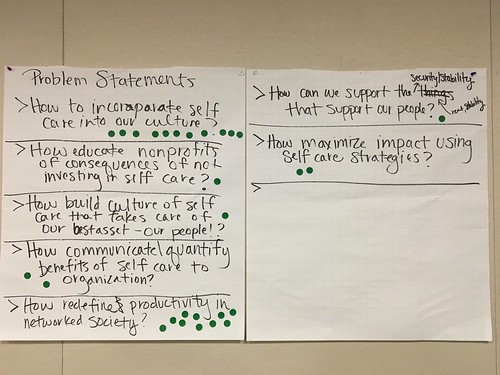
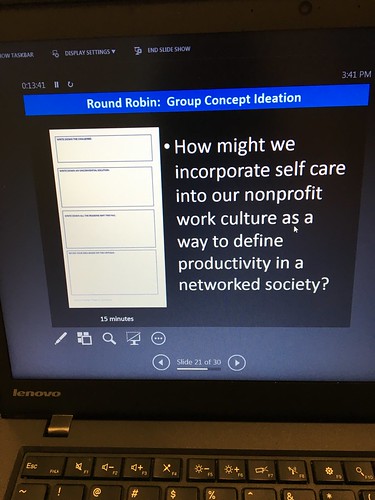
After doing a keynote talk about the idea in my next book, I facilitated a design lab at Alliance for Nonprofit Management Conference which included executive directors and people who worked in philanthropy, research, and evaluation. After doing a problem analysis, we re-framed the question as “How might we incorporate self care into our nonprofit work culture as a way to define productivity in a networked society?” These ideas take more a systems lens to educating the sector about the importance of self-care.
Selfcare Peer Program: You Are Better, We Are Better
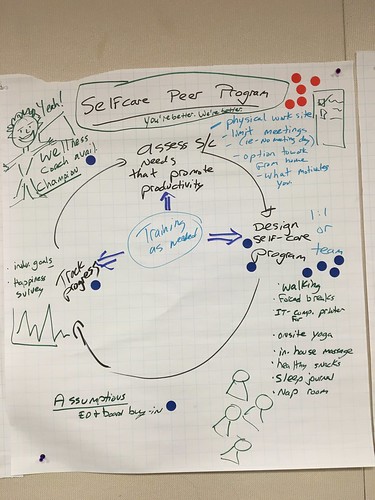
Self Care Peer to Peer Program – You’re Better, We’re Better
This program would include a self-assessment that would help individuals create a customized plan that would support increased productivity. There would be policies and practices around having a “no meeting day,” option to work from home, a quiet room in the office, and other activities. The program would have wellness coaches who would champion the ideas for individual self-care activities that individuals would pick and choose. This might include encouragement to take walking breaks, healthy snacks, encourage sleep journals, and healthy practices outside of work. The program would track progress against nonprofit goals so it could link individual actions to productivity.
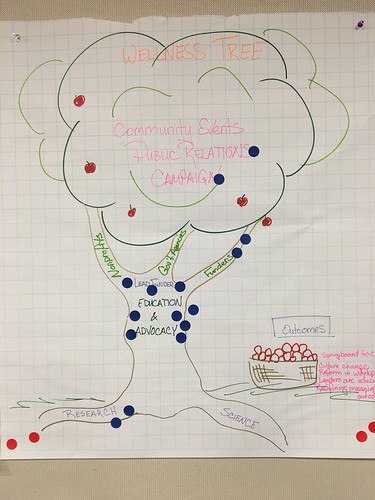
The Wellness Tree
This idea would take a systems approach to self-care. It would convene a large group of nonpofits in a region for a conference about selfcare within nonprofits and how replenish energy while delivering on mission. There would an effort to educate funders to buy into supporting research and science about self-care reform in the nonprofit workplace. It would have a measurement component that would link self-care to results and provide a springboard for culture change in the organization.
Switching from scarcity to abundance when it comes to self-care for nonprofits includes a multi-faceted approach — educational for individuals who can take self-care into their own hands, crafting a strategy and practice using much of the great tips that are out there. At the time, it needs to scale within nonprofits so it is embedded in the culture and that takes a systems approach based on science and research and funder support.
What is your nonprofit’s mindset when comes to self-care? Is it the scarcity mindset or abundance mindset? How to switch from scarcity to abundance thinking when it comes to self-care?
Beth Kanter is a consultant, author, influencer. virtual trainer & nonprofit innovator in digital transformation & workplace wellbeing.
